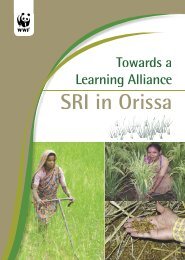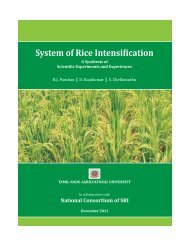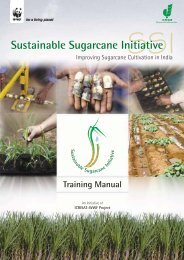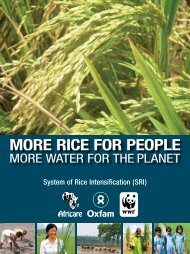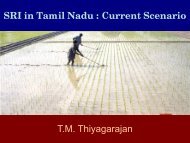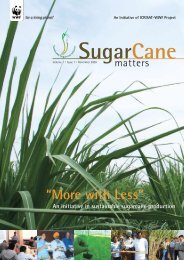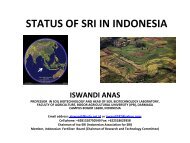Century of Rice farmers' innovation in farm based - SRI - India
Century of Rice farmers' innovation in farm based - SRI - India
Century of Rice farmers' innovation in farm based - SRI - India
You also want an ePaper? Increase the reach of your titles
YUMPU automatically turns print PDFs into web optimized ePapers that Google loves.
<strong>Century</strong> <strong>of</strong> <strong>Rice</strong> <strong>farm</strong>ers’ <strong><strong>in</strong>novation</strong> <strong>in</strong> <strong>farm</strong> <strong>based</strong><br />
approaches, experiences and lessons with <strong>SRI</strong> and way<br />
forward for future rice production and quality with<strong>in</strong> the<br />
context <strong>of</strong> climate change<br />
Biksham Gujja and T.M. Thiyagarajan<br />
<br />
1. <strong>Rice</strong> and <strong>India</strong><br />
<strong>Rice</strong> is not every th<strong>in</strong>g <strong>in</strong> <strong>India</strong>, but every th<strong>in</strong>g <strong>in</strong> most parts <strong>of</strong> <strong>India</strong> starts and ends<br />
with rice. It is more an <strong>in</strong>tegral part <strong>of</strong> <strong>India</strong>n culture. It is life l<strong>in</strong>e; this life l<strong>in</strong>e has<br />
extended <strong>in</strong> more than 540 districts <strong>of</strong> 604 districts <strong>in</strong> <strong>India</strong>. It is a versatile crop<br />
grown <strong>in</strong> all most all agro-climatic zones except on the very high altitudes, glaciers.<br />
The name <strong>of</strong> the global gra<strong>in</strong> rice probably has its roots <strong>in</strong> <strong>India</strong>. Accord<strong>in</strong>g to the<br />
Micros<strong>of</strong>t Encarta Dictionary (2004) and the Chambers Dictionary <strong>of</strong> Etymology<br />
(1988), the word rice has an Indo-Iranian orig<strong>in</strong>. It came to English from Greek óryza,<br />
via Lat<strong>in</strong> oriza, Italian riso and f<strong>in</strong>ally Old French ris. It has been speculated that the<br />
Indo-Iranian vrihi itself is borrowed from a Dravidian vari or even a Munda language<br />
term for rice, or the Tamil name arisi which the Arabic ar-ruzz, from which the<br />
Portuguese and Spanish word arroz orig<strong>in</strong>ated (http://en.wikipedia.org/wiki/<strong>Rice</strong>).<br />
In <strong>India</strong>, rice cultivation probably began <strong>in</strong> the upper and middle Ganges between<br />
2000 and 1500 B.C. It expanded quickly after irrigation works spread from Orissa<br />
State to the adjo<strong>in</strong><strong>in</strong>g areas <strong>of</strong> Andhra Pradesh and Tamil Nadu <strong>in</strong> the Iron Age<br />
around 300 B.C. ( http://www.cambridge.org/us/books/kiple/rice.htm).<br />
<strong>Rice</strong> is first mentioned <strong>in</strong> the Yajur Veda (c. 1500-800 BC) and then is frequently<br />
referred to <strong>in</strong> Sanskrit texts, which dist<strong>in</strong>guished summer varieties from ra<strong>in</strong>y season<br />
and w<strong>in</strong>ter varieties. Shali or w<strong>in</strong>ter varieties were most highly regarded. About 2000<br />
years ago, rice was well-established as the ma<strong>in</strong> cereal <strong>of</strong> the sub-cont<strong>in</strong>ent, with<br />
barley second and wheat a barely mentioned w<strong>in</strong>ter food. Greek visitors noted the<br />
popularity <strong>of</strong> rice amongst <strong>India</strong>ns. The Greek emissary Megasthenes, visit<strong>in</strong>g<br />
Pataliputra (modern Patna) <strong>in</strong> 315 BC, wrote that they ate it ceremonially, boiled,<br />
placed <strong>in</strong> a bowl and then various other dishes added to it. Hundreds <strong>of</strong> years later, the<br />
Portuguese <strong>in</strong> the 15th century observed cooked rice be<strong>in</strong>g eaten <strong>in</strong> much the same<br />
way. The 17th century traveller Francois Bernier described fields <strong>of</strong> rice <strong>in</strong> Kashmir<br />
and Bengal, irrigated by endless channels. The Muslim rulers <strong>of</strong> <strong>India</strong> created famous<br />
rice and meat dishes such as pilafs and biriyanis. The number <strong>of</strong> dishes made with<br />
rice was by this time legion. Annapurna is the H<strong>in</strong>du god <strong>of</strong> rice. Her name comes<br />
from the Sanskrit word for rice, anna. She is <strong>of</strong>ten depicted with a rice spoon <strong>in</strong> her<br />
hand. In pen<strong>in</strong>sular <strong>India</strong>, there are numerous festivals connected with the sow<strong>in</strong>g,<br />
plant<strong>in</strong>g and harvest<strong>in</strong>g <strong>of</strong> rice. Major harvest festivals <strong>in</strong>clude Pongal <strong>in</strong> Tamil Nadu,<br />
Onam <strong>in</strong> Kerala, Huthri <strong>in</strong> Coorg (Kodagu). <strong>Rice</strong>, t<strong>in</strong>ted with the auspicious yellow<br />
colour <strong>of</strong> turmeric, is showered onto newly-married couples, and is part <strong>of</strong> numerous<br />
rites and celebrations. It is <strong>of</strong>fered to the deities and used as an oblation <strong>in</strong> the sacred<br />
fire <strong>of</strong> H<strong>in</strong>du ritual. <strong>Rice</strong> is used <strong>in</strong> many <strong>India</strong>n celebrations, <strong>in</strong>clud<strong>in</strong>g wedd<strong>in</strong>gs.<br />
<strong>Rice</strong> features <strong>in</strong> many legends about the Buddha's life. In a famous tale, he was<br />
<strong>of</strong>fered a bowl <strong>of</strong> milk and rice by a young woman named Sujata, which gave him,
enewed strength dur<strong>in</strong>g his austerities <strong>in</strong> pursuit <strong>of</strong> Enlightenment. Sweetened rice<br />
thus forms part <strong>of</strong> <strong>of</strong>fer<strong>in</strong>gs to the Buddha <strong>in</strong> Buddhist ceremonies.<br />
( http://www.plantcultures.org/plants/rice_history.html)<br />
<strong>India</strong> is one <strong>of</strong> the richest countries <strong>in</strong> the world <strong>in</strong> terms <strong>of</strong> possess<strong>in</strong>g tremendous<br />
diversity <strong>in</strong> rice varieties. There are different varieties <strong>of</strong> rice-depend<strong>in</strong>g on the<br />
weather, soil, structure, characteristics and purposes. Accord<strong>in</strong>g to Dr. Richaria, one<br />
<strong>of</strong> the most em<strong>in</strong>ent rice scientists <strong>of</strong> the world, 4,00,000 varieties <strong>of</strong> rice existed <strong>in</strong><br />
<strong>India</strong> dur<strong>in</strong>g the Vedic period. He estimated that, even today 2,00,000 varieties <strong>of</strong> rice<br />
exist <strong>in</strong> <strong>India</strong>, which is <strong>in</strong>deed an exceptionally high number. This means that even if<br />
a person eats a new rice variety every day <strong>of</strong> the year he has to live for over hundred<br />
years without reus<strong>in</strong>g a variety. Every variety has a specific purpose and utility.<br />
(http://www.rice-trade.com/)<br />
2. <strong>Rice</strong> Production <strong>in</strong> <strong>India</strong><br />
<strong>India</strong> has the world’s largest area devoted to rice cultivation, and it is the second<br />
largest producer <strong>of</strong> rice after Ch<strong>in</strong>a. Over half <strong>of</strong> its rice area is irrigated, contribut<strong>in</strong>g<br />
75% <strong>of</strong> the total production, but also consum<strong>in</strong>g 50-60% <strong>of</strong> the nation’s f<strong>in</strong>ite<br />
freshwater resources. Of the country’s 1.15 billion <strong>in</strong>habitants, 70% rely on rice for at<br />
least a third <strong>of</strong> their energy requirements. <strong>India</strong>’s population is projected to grow to<br />
1.6 billion <strong>in</strong> 2050, putt<strong>in</strong>g tremendous stra<strong>in</strong> on its land and water resources.<br />
<strong>India</strong> shares around 21 % <strong>of</strong> global rice production from about 28 % <strong>of</strong> rice area<br />
(Figure 2). <strong>Rice</strong> area <strong>in</strong> <strong>India</strong> fluctuates around 43 million hectares dur<strong>in</strong>g the last two<br />
decades and was at a maximum <strong>of</strong> 45.5 million hectares <strong>in</strong> 2008-09 (Figure 2). Total<br />
rice production was also the maximum (99.2 million tonnes) dur<strong>in</strong>g this year. Rough<br />
rice productivity which was at 1002 kg/ha <strong>in</strong> 1950-51 had reached a maximum <strong>of</strong><br />
3303 kg/ha <strong>in</strong> 2007-08. Interest<strong>in</strong>gly the rough rice productivity dur<strong>in</strong>g the early 20 th<br />
century was around 1600 kg/ha, which decl<strong>in</strong>ed to 1139 kg/ha dur<strong>in</strong>g 1940-41 (Figure<br />
3).<br />
Gra<strong>in</strong> production <strong>in</strong> <strong>India</strong>, follow<strong>in</strong>g the Green Revolution <strong>in</strong> 1969-70, yielded 99.5<br />
million tonnes and nearly doubled by the end <strong>of</strong> the last century. The highest average<br />
annual <strong>in</strong>crease <strong>of</strong> 6.1% <strong>in</strong> gra<strong>in</strong> production was recorded dur<strong>in</strong>g the 1980s: from 110<br />
million t <strong>in</strong> 1979-80 to 171 million t <strong>in</strong> 1989-90; but the annual <strong>in</strong>crease <strong>in</strong> gra<strong>in</strong><br />
production dur<strong>in</strong>g the 1990s dropped to 1.5%.<br />
<strong>India</strong> produced about 40 per cent <strong>of</strong> the world's exportable surplus <strong>of</strong> rice dur<strong>in</strong>g<br />
1913-14. This scenario changed subsequently and the country faced a severe fam<strong>in</strong>e<br />
<strong>in</strong> 1943. Export <strong>of</strong> milled rice was a mere 0.5 million tonnes <strong>in</strong> 1989 but reached a<br />
maximum <strong>of</strong> 6.7 million tonnes dur<strong>in</strong>g 2001.
Millionhecatres<br />
200<br />
150<br />
100<br />
50<br />
196061<br />
200809<br />
Milliontonnes<br />
800<br />
600<br />
400<br />
200<br />
196061<br />
200809<br />
Gra<strong>in</strong>yield(t/ha)<br />
5<br />
4<br />
3<br />
2<br />
1<br />
196061<br />
200809<br />
0<br />
World<br />
<strong>India</strong><br />
0<br />
World<br />
<strong>India</strong><br />
0<br />
World<br />
<strong>India</strong><br />
Figure 1. <strong>Rice</strong> area, rough rice production and productivity <strong>in</strong> the world and <strong>India</strong><br />
dur<strong>in</strong>g 1960-61 and 2008-09.<br />
Figure 2. Rough rice yield <strong>in</strong> <strong>India</strong> s<strong>in</strong>ce the beg<strong>in</strong>n<strong>in</strong>g <strong>of</strong> 20 th century. The data for<br />
1900-01, 1910-11, 1920-21 and 1930-31 are averages for 1900-01 to 1904-05, 1910-<br />
11 to 1914-15, 1920-21 to 1924-25 and 1930-31 to 1934-35 respectively (Source:<br />
Baljit S<strong>in</strong>gh. 1945. Whither Agriculture <strong>in</strong> <strong>India</strong>. N.R. Agarwal & Co, Agra). The<br />
data for 2010-11 are estimates (Source: Directorate <strong>of</strong> Economics and Statistics,<br />
Agricultural Statistics at a glance 2010. Department <strong>of</strong> Agriculture and Cooperation,<br />
M<strong>in</strong>istry <strong>of</strong> Agriculture, Govt. <strong>of</strong> <strong>India</strong>, New Delhi.
Figure 3. <strong>Rice</strong> area, rough rice production and productivity dur<strong>in</strong>g 1950-51 to 2010-<br />
11 (Data for 2009-10 and 2010-11 are estimates)<br />
Source: Directorate <strong>of</strong> Economics and Statistics, 2008. Agricultural Statistics at a<br />
glance 2010. Department <strong>of</strong> Agriculture and Cooperation, M<strong>in</strong>istry <strong>of</strong> Agriculture,<br />
Govt.<strong>of</strong> <strong>India</strong>, New Delhi.
3. Quest for improv<strong>in</strong>g the yields<br />
<strong>India</strong>n <strong>farm</strong>ers and rulers always focus on improv<strong>in</strong>g the yields as effective way <strong>of</strong><br />
improv<strong>in</strong>g the food security. While <strong>in</strong>vestments have gone <strong>in</strong> expand<strong>in</strong>g the area by<br />
the rulers, the efforts and <strong><strong>in</strong>novation</strong> by largely <strong>farm</strong>ers cont<strong>in</strong>ued <strong>in</strong> improv<strong>in</strong>g the<br />
yields <strong>of</strong> per unit <strong>of</strong> area. Until last five decades or so, these efforts are largely or even<br />
exclusively <strong>farm</strong> <strong>based</strong>, select<strong>in</strong>g the suitable varieties for different agro-climatic<br />
zones with improv<strong>in</strong>g the soil, water and organic <strong>in</strong>put management to achieve the<br />
maximum yields.<br />
Most strik<strong>in</strong>g and <strong>in</strong>genious attempt which has come to limelight is the gaja plant<strong>in</strong>g<br />
- with its own name and the specifications. When we were exam<strong>in</strong><strong>in</strong>g why <strong>in</strong> a<br />
country with long experience <strong>of</strong> rice cultivation, no <strong>in</strong>novative method was tried to<br />
<strong>in</strong>crease the yield with reduced <strong>in</strong>puts. A simple thought and a bit <strong>of</strong> luck has led to a<br />
major breakthrough <strong>in</strong> document<strong>in</strong>g an approach known to Tamil <strong>farm</strong>ers a century<br />
ago. Today System <strong>of</strong> <strong>Rice</strong> Intensification (<strong>SRI</strong>) is known to many rice <strong>farm</strong>ers <strong>of</strong><br />
Tamil Nadu as ‘Ottrai Natru Nadavu’ (s<strong>in</strong>gle seedl<strong>in</strong>g plant<strong>in</strong>g). This recognition has<br />
come through <strong>SRI</strong>. But, to our surprise, we f<strong>in</strong>d that s<strong>in</strong>gle seedl<strong>in</strong>g plant<strong>in</strong>g was<br />
known 100 years ago <strong>in</strong> Tamil Nadu.<br />
A century ago, an <strong>in</strong>novative <strong>farm</strong>er <strong>in</strong> Tamil Nadu, had the idea <strong>of</strong> modify<strong>in</strong>g<br />
exist<strong>in</strong>g agronomic practices <strong>in</strong> rice cultivation with s<strong>in</strong>gle seedl<strong>in</strong>gs, wider spac<strong>in</strong>g,<br />
and some <strong>in</strong>tercultivation operation and reported a yield <strong>of</strong> 6,004 kg ha –1 . This gaja<br />
method employed <strong>in</strong>ter-row spac<strong>in</strong>g <strong>of</strong> 1 1/2 feet (45 cm) and with<strong>in</strong>-row spac<strong>in</strong>g <strong>of</strong> 1<br />
foot (30 cm) between s<strong>in</strong>gle plants, result<strong>in</strong>g <strong>in</strong> a plant population <strong>of</strong> only 7–8 plants<br />
m –2 . Further research <strong>in</strong>to the history <strong>of</strong> rice cultivation <strong>in</strong> Tamil Nadu has revealed<br />
that <strong>in</strong> 1,911 several <strong>farm</strong>ers published articles <strong>in</strong> Tamil language on s<strong>in</strong>gle-seedl<strong>in</strong>g<br />
plant<strong>in</strong>g (Kulandai Veludaiyar 1911, Anonymous 1911). The scanned copies <strong>of</strong> these<br />
articles <strong>in</strong> Tamil and their English versions have been published separately<br />
(Thiyagarajan and Gujja 2009). It was also found that this s<strong>in</strong>gle-seedl<strong>in</strong>g plant<strong>in</strong>g<br />
was popularized by the then British Government <strong>in</strong> the Madras Presidency. By 1914,<br />
s<strong>in</strong>gle-seedl<strong>in</strong>g plant<strong>in</strong>g was be<strong>in</strong>g adopted <strong>in</strong> 40,468 ha (Chadwick 1914).<br />
Vaidyal<strong>in</strong>gam Pillai’s reported yield <strong>of</strong> 6,004 kg gra<strong>in</strong> ha -1 with gaja plant<strong>in</strong>g methods<br />
<strong>in</strong> Thanjavur District was 2.7 times more than that obta<strong>in</strong>ed from the same field the<br />
previous year when us<strong>in</strong>g bunch plant<strong>in</strong>g. Yanagisawa (1996) has estimated that the<br />
average rice yield <strong>in</strong> Thanjavur District dur<strong>in</strong>g 1911 was 1,693 kg paddy ha -1 , while<br />
the average yield <strong>in</strong> this district for the period 1911-1915 was 1,492 kg ha -1<br />
(Sivasubramanian 1961).<br />
It is fasc<strong>in</strong>at<strong>in</strong>g that such high yields were be<strong>in</strong>g obta<strong>in</strong>ed by <strong>farm</strong>ers with their own<br />
<strong><strong>in</strong>novation</strong>s a century ago, when no chemical fertilizers were applied. Unfortunately,<br />
such <strong>farm</strong>er <strong><strong>in</strong>novation</strong>s have disappeared after scientific recommendations have taken<br />
over by Green Revolution.<br />
<strong>Rice</strong> Breed<strong>in</strong>g<br />
Develop<strong>in</strong>g improved varieties has been one <strong>of</strong> the major thrust areas s<strong>in</strong>ce the<br />
beg<strong>in</strong>n<strong>in</strong>g <strong>of</strong> rice research. <strong>Rice</strong> breed<strong>in</strong>g programme <strong>in</strong> <strong>India</strong> was started by Dr. G.<br />
P. Hector, the then Economic Botanist dur<strong>in</strong>g 1911 <strong>in</strong> undivided Bengal with<br />
headquarters at Dacca (now <strong>in</strong> Bangladesh). Subsequently, <strong>in</strong> 1912, a crop specialist<br />
was appo<strong>in</strong>ted exclusively for rice <strong>in</strong> Madras Prov<strong>in</strong>ce. Prior to the establishment <strong>of</strong><br />
the <strong>India</strong>n Council <strong>of</strong> Agricultural Research (ICAR) <strong>in</strong> 1929, Bengal and Madras
were the only prov<strong>in</strong>ces, which had specialist exclusively for rice crop. After the<br />
establishment <strong>of</strong> ICAR, it has <strong>in</strong>itiated the rice research projects <strong>in</strong> various states <strong>of</strong><br />
the country and by 1950, 82 research stations <strong>in</strong> 14 states <strong>of</strong> the country were<br />
established, fully devoted for rice research projects.<br />
Major chronological events <strong>in</strong> rice breed<strong>in</strong>g were:<br />
1911-1949: Pure l<strong>in</strong>e selections and very few hybridizations<br />
1950-1964: Inter-racial hybridization between japonicas and <strong>in</strong>dicas<br />
1965 - : Inter-racial hybridization with semi dwarfs<br />
1970 - : Development <strong>of</strong> hybrid rice<br />
(http://dacnet.nic.<strong>in</strong>/rice/<strong>Rice</strong>%20Varieties%20<strong>in</strong>%20<strong>India</strong>.htm)<br />
More than 700 varieties have so far been released <strong>in</strong> the country by national and state<br />
research establishments.<br />
Soil and Crop Management<br />
Besides <strong>in</strong>troduc<strong>in</strong>g high yield<strong>in</strong>g variety, management practices towards better<br />
nutrient supply, soil and water management, protect<strong>in</strong>g the crop from pest and<br />
diseases and exploit<strong>in</strong>g the genetic potential <strong>of</strong> the crop, have been developed and is<br />
be<strong>in</strong>g cont<strong>in</strong>ued now. These practices are recommended to <strong>farm</strong>ers for adoption. The<br />
major implications <strong>of</strong> these recommendations were on <strong>in</strong>creased use <strong>of</strong> chemical<br />
fertilizers and plant protection chemicals.<br />
Green Revolution<br />
The Green Revolution took place between 1967 and 1978, which <strong>in</strong>volved<br />
improvements <strong>in</strong> agricultural practices that dramatically <strong>in</strong>creased food production,<br />
especially wheat and rice. The government began to develop more <strong>farm</strong>land and<br />
<strong>in</strong>troduced modern irrigation systems, mak<strong>in</strong>g it possible for <strong>farm</strong>ers to plant two<br />
crops a year <strong>in</strong>stead <strong>of</strong> one. <strong>India</strong>n <strong>farm</strong>ers also planted genetically improved seeds<br />
that greatly <strong>in</strong>creased crop yields. With<strong>in</strong> a decade, <strong>India</strong> had become one <strong>of</strong> the<br />
world’s largest producers <strong>of</strong> <strong>farm</strong> products. In some years, <strong>farm</strong>ers produced more<br />
food gra<strong>in</strong>s than the <strong>India</strong>n people needed, so they sold the excess to other countries.<br />
Fam<strong>in</strong>e <strong>in</strong> <strong>India</strong>, once accepted as <strong>in</strong>evitable, has not returned s<strong>in</strong>ce the <strong>in</strong>troduction<br />
<strong>of</strong> Green Revolution crops (http://www.bigsite<strong>of</strong>amaz<strong>in</strong>gfacts.com).<br />
In wheat, for example, production <strong>in</strong>creased by a third from 12.3 million tons <strong>in</strong> 1964-<br />
1965 to 16.6 million tons <strong>in</strong> 1967-68 and 20 million tons <strong>in</strong> 1969-1970. <strong>Rice</strong><br />
production <strong>in</strong>creased more slowly (due to the later <strong>in</strong>troduction <strong>of</strong> IR-8), grow<strong>in</strong>g<br />
from 30.5 million tons <strong>in</strong> 1964-65 to 40 million tons <strong>in</strong> 1969-1970. More<br />
importantly, these ga<strong>in</strong>s <strong>in</strong> yield were resilient to fluctuations <strong>in</strong> the monsoon, the<br />
primary natural driver <strong>of</strong> <strong>India</strong>n macro-level food shortages. An early example <strong>of</strong> this<br />
was <strong>in</strong> the poor weather <strong>of</strong> 1968-1969, which caused a decrease <strong>of</strong> only two percent<br />
aga<strong>in</strong>st the previous year’s record yield. By 1977, <strong>India</strong> no longer required structural<br />
cereal imports, and <strong>in</strong> later years became an <strong>in</strong>termittent exporter. Clearly, these<br />
statistics show that <strong>India</strong> achieved the primary goal <strong>of</strong> the Green Revolution, the<br />
restoration <strong>of</strong> agricultural self-sufficiency on the national level (Arena, 2005).<br />
The achievements through Green Revolution has come with a price- ignor<strong>in</strong>g<br />
traditional varieties and higher use <strong>of</strong> chemical fertilizers forgett<strong>in</strong>g organic sources<br />
obta<strong>in</strong>ed through animals and plants and most importantly total dependence <strong>of</strong>
<strong>farm</strong>ers not only for seeds, fertilizers, pesticides but even for the knowledge and<br />
cultivation method etc. By the end <strong>of</strong> green revolution, with erosion <strong>of</strong> local varieties,<br />
replacement <strong>of</strong> organic fertilizers, total dependence <strong>of</strong> <strong>farm</strong>ers on scientific<br />
<strong>in</strong>stitutions for guidance and advise has resulted <strong>in</strong> agriculture be<strong>in</strong>g driven by factors<br />
other than <strong>farm</strong>ers <strong>in</strong> every sphere.<br />
Significant impact events on rice <strong>in</strong> <strong>India</strong><br />
1906 Introduction <strong>of</strong> S<strong>in</strong>gle Seedl<strong>in</strong>g Plant<strong>in</strong>g <strong>in</strong> Madras Presidency<br />
1911 Introduction <strong>of</strong> Gaja Plant<strong>in</strong>g <strong>in</strong> Madras Presidency<br />
1914 Beg<strong>in</strong>n<strong>in</strong>g <strong>of</strong> systematic study on rice <strong>in</strong> Coimbatore<br />
1946 Establishment <strong>of</strong> Central <strong>Rice</strong> Research Institute at Cuttack<br />
1951 Introduction <strong>of</strong> Japanese method <strong>of</strong> rice cultivation<br />
1965 Launch<strong>in</strong>g <strong>of</strong> All <strong>India</strong> Coord<strong>in</strong>ated <strong>Rice</strong> Improvement Project (ICAR)<br />
1969 Introduction <strong>of</strong> IR8 variety, Surge <strong>in</strong> expansion <strong>of</strong> rice area <strong>in</strong> Punjab<br />
2000 Introduction <strong>of</strong> <strong>SRI</strong><br />
Concerns <strong>in</strong> rice production<br />
Much <strong>of</strong> the green revolution’s ga<strong>in</strong>s have been achieved through highly <strong>in</strong>tensive<br />
agriculture that depends heavily on fossil fuels for <strong>in</strong>puts and energy. Whether more<br />
food can be produced without damag<strong>in</strong>g the soils and fresh water and crop diversity is<br />
questionable as these food produc<strong>in</strong>g bases are be<strong>in</strong>g degraded <strong>in</strong> many places.<br />
Rough rice production has <strong>in</strong>creased <strong>in</strong> <strong>India</strong> 4.68 times <strong>in</strong> the last 57 years – from<br />
30.9 million tonnes (1950-51) to 148.4 million tonnes (2008-09). Enhancement <strong>in</strong> rice<br />
production is ma<strong>in</strong>ly credited to a productivity-led <strong>in</strong>crease s<strong>in</strong>ce harvested rice area<br />
for the correspond<strong>in</strong>g period has expanded from 31 m ha to about 44 m ha,<br />
account<strong>in</strong>g for only 42 per cent <strong>in</strong>crease.<br />
Gra<strong>in</strong> demand <strong>in</strong> <strong>India</strong> is estimated to be about 300 million t per annum by 2020,<br />
necessitat<strong>in</strong>g an <strong>in</strong>crease <strong>of</strong> about 91 million t from the estimated 209 million t<br />
production for 2005-06. S<strong>in</strong>ce there is no probability <strong>of</strong> any further <strong>in</strong>crease <strong>in</strong> the<br />
area under cultivation over the present 142 million ha, much <strong>of</strong> the desired <strong>in</strong>crease <strong>in</strong><br />
gra<strong>in</strong> production has to be atta<strong>in</strong>ed by enhanc<strong>in</strong>g the productivity per unit area. The<br />
productivity <strong>of</strong> milled rice has to be <strong>in</strong>creased from the present 2,077 kg ha –1 to 2,895<br />
kg ha –1 by 2020 with an average <strong>in</strong>crease <strong>of</strong> about 5% per annum (NAAS, 2006).<br />
A historical analysis by Barah (2005) shows that over the decades, the phenomenal<br />
pace <strong>in</strong> <strong>in</strong>crease <strong>in</strong> rice production has been uneven and the regional disparity highly<br />
pervasive among the States as well as across the diverse ecosystems. Clearly, the ga<strong>in</strong><br />
due to modern rice technology has been discrim<strong>in</strong>atory aga<strong>in</strong>st the resource poor<br />
areas, which is also dom<strong>in</strong>ated by small and marg<strong>in</strong>al <strong>farm</strong>ers. The analysis also<br />
br<strong>in</strong>gs out a dist<strong>in</strong>ct production divide between irrigated tracts and ra<strong>in</strong>fed areas,<br />
which substantiated the <strong>in</strong>terregional disparity <strong>in</strong> production and productivity <strong>in</strong> rice.<br />
About 36 percent <strong>of</strong> the districts cover<strong>in</strong>g 44 per cent total rice area <strong>in</strong> the country<br />
achieved productivity level <strong>of</strong> more than 2tonnes/ha (approx 3 tonnes/ha <strong>of</strong> rough<br />
paddy). The average rice yield was <strong>in</strong> the range l-2tonnes/ha <strong>in</strong> 90 percent <strong>of</strong> the rice<br />
area <strong>of</strong> eastern <strong>India</strong> dur<strong>in</strong>g 1970-79. But dur<strong>in</strong>g 1990-97, this has changed<br />
substantially, whereby only 47 percent <strong>of</strong> the rice area was <strong>in</strong> this yield range, and 51<br />
percent <strong>of</strong> the area <strong>in</strong>creased yield levels higher than 2tonnes/ha.
The rice production data for 2006-07 shows the rough rice productivity is below 2 t<br />
ha -1 <strong>in</strong> about 18.7 % (8 million ha) <strong>of</strong> total paddy area spread over 150 districts and<br />
contribut<strong>in</strong>g only 9.0 % <strong>of</strong> total production (Table 1). This situation after four<br />
decades <strong>of</strong> green revolution and huge <strong>in</strong>vestments speaks <strong>of</strong> the rice production<br />
conditions <strong>of</strong> these areas.<br />
Table 1. Rough rice productivity range <strong>in</strong> <strong>India</strong>, 2006-07<br />
Yield<br />
(t/ha)<br />
No. <strong>of</strong><br />
Districts<br />
Area<br />
(000'ha)<br />
Production<br />
(000'tonnes)<br />
< 1 33 444 369<br />
1 – 1.5 56 3139 3957<br />
1.5 - 2 61 4626 8198<br />
2 – 2.5 106 8646 19343<br />
2.5 - 3 68 4559 12528<br />
3 – 3.5 58 5294 17038<br />
3.5 - 4 65 5944 22516<br />
> 4 106 11235 55257<br />
Total 553 43,887 139,206<br />
The growth rates <strong>of</strong> rice area, production and productivity dur<strong>in</strong>g 1994-95 to 2009-10<br />
were (-) 0.04, 1.15 and 1.04 respectively. The growth rate <strong>of</strong> area went down by (-)<br />
8.30 <strong>in</strong> 2002-03 and reached a maximum <strong>of</strong> 4.18 dur<strong>in</strong>g 2005-06. The negative<br />
growth rates <strong>of</strong> production and yield were highest dur<strong>in</strong>g 2002-03 (Figure 4). The<br />
impact <strong>of</strong> the delayed and sub-normal monsoon was reflected <strong>in</strong> reduced area under<br />
rice cultivation dur<strong>in</strong>g 2009-10 over 2008-09 by 14.3 per cent. (Annual Report 2009-<br />
10, NABARD).<br />
Figure 4. Growth rates <strong>in</strong> rice area, production and yield dur<strong>in</strong>g 1994-95 to 2009-<br />
2010 (Data for 2009-10 and 2010-11 are estimates)<br />
Source : Directorate <strong>of</strong> Economics and Statistics, 2008. Agricultural Statistics at a<br />
glance 2010. Department <strong>of</strong> Agriculture and Cooperation, M<strong>in</strong>istry <strong>of</strong> Agriculture,<br />
Govt.<strong>of</strong> <strong>India</strong>, New Delhi.
The per capita net availability <strong>of</strong> rice which was at 159 grams/day dur<strong>in</strong>g 1950-51<br />
<strong>in</strong>creased to 200 – 2008 grams/day dur<strong>in</strong>g 1990 to 2002 but has been below 200<br />
grams/day after that.<br />
<strong>India</strong>’s post-<strong>in</strong>dependence agricultural growth <strong>in</strong>volved huge <strong>in</strong>vestments <strong>in</strong> irrigation<br />
projects that resulted <strong>in</strong> more than a tripl<strong>in</strong>g <strong>in</strong> the gross irrigated area from 22.6<br />
million hectares (1950-51) to 76.3 million hectares (1999-00). This has contributed to<br />
a drastic reduction <strong>in</strong> per capita fresh water availability, from 5,410 cubic meters to<br />
1900 cubic metres dur<strong>in</strong>g that period. The greatest growth <strong>of</strong> irrigation has been<br />
through the <strong>in</strong>stallation <strong>of</strong> wells. In some regions, over- exploitation <strong>of</strong> ground water<br />
supplies through pump extraction is lead<strong>in</strong>g to serious decl<strong>in</strong>es <strong>in</strong> ground water levels.<br />
<strong>India</strong> is the largest user <strong>of</strong> groundwater <strong>in</strong> the world (over a quarter <strong>of</strong> the global<br />
total); 60% <strong>of</strong> irrigated agriculture and 85% <strong>of</strong> dr<strong>in</strong>k<strong>in</strong>g water supplies are dependent<br />
on groundwater. Accord<strong>in</strong>g to the World Bank, if current trends cont<strong>in</strong>ue, <strong>in</strong> 20 years<br />
about 60% <strong>of</strong> all aquifers <strong>in</strong> <strong>India</strong> will be <strong>in</strong> a critical condition. This will have serious<br />
implications for the susta<strong>in</strong>ability <strong>of</strong> agriculture, long-term food security, livelihoods,<br />
and economic growth. It is estimated that over a quarter <strong>of</strong> the country’s harvest will<br />
be at risk. There is an urgent need to change the status quo.<br />
<strong>Rice</strong> cultivation is <strong>in</strong> crisis world over and <strong>India</strong> is no exception with shr<strong>in</strong>k<strong>in</strong>g area<br />
<strong>of</strong> rice cultivation, fluctuat<strong>in</strong>g annul productions, stagnant yields, water scarcity and<br />
escalat<strong>in</strong>g <strong>in</strong>put costs. The cost <strong>of</strong> cultivation <strong>of</strong> paddy has consistently been<br />
<strong>in</strong>creas<strong>in</strong>g ow<strong>in</strong>g to escalat<strong>in</strong>g costs <strong>of</strong> labour and <strong>in</strong>puts. With <strong>in</strong>creas<strong>in</strong>g labour<br />
scarcity due to urbanization, susta<strong>in</strong><strong>in</strong>g the <strong>in</strong>terest <strong>of</strong> the <strong>farm</strong>ers <strong>in</strong> rice cultivation<br />
itself has become a challenge.<br />
The current productivity is much lower than many other rice produc<strong>in</strong>g countries and<br />
need to be enhanced under the circumstances <strong>of</strong> less hope for <strong>in</strong>crease <strong>in</strong> area and<br />
irrigation potential. Dur<strong>in</strong>g the last decade the percent irrigated rice area has been<br />
fluctuat<strong>in</strong>g around 53 % show<strong>in</strong>g no appreciable <strong>in</strong>crease.<br />
The future <strong>of</strong> country’s rice production will depend heavily on develop<strong>in</strong>g and<br />
adopt<strong>in</strong>g strategies and practices that will use irrigation water efficiently at <strong>farm</strong> level.<br />
The country needs its <strong>in</strong>crease its paddy production at the rate <strong>of</strong> 3.75 million tonnes<br />
per year until 2050 to meet its food security. The paddy productivity <strong>in</strong> many states<br />
requires to be enhanced from the current level.<br />
<strong>Rice</strong> production today faces a number <strong>of</strong> problems that threaten many rice produc<strong>in</strong>g<br />
Asian countries’ ability to support the food needs <strong>of</strong> their rapidly grow<strong>in</strong>g<br />
populations. These constra<strong>in</strong>ts <strong>in</strong>clude pest outbreaks, diseases, soil degradation,<br />
scarcity <strong>of</strong> water, conversion <strong>of</strong> rice lands for <strong>in</strong>dustrial use, soil sal<strong>in</strong>isation and<br />
adverse soil conditions. Contrary to the claims <strong>of</strong> genetic eng<strong>in</strong>eer<strong>in</strong>g proponents, the<br />
real cutt<strong>in</strong>g edge solutions to the problems <strong>of</strong> rice production lie not <strong>in</strong> develop<strong>in</strong>g GE<br />
rice but rather <strong>in</strong> develop<strong>in</strong>g and/or adopt<strong>in</strong>g strategies that take advantage <strong>of</strong><br />
ecological pr<strong>in</strong>ciples with<strong>in</strong> agricultural systems, and <strong>in</strong>tegrat<strong>in</strong>g traditional <strong>farm</strong><strong>in</strong>g<br />
practices with modern scientific knowledge. Exist<strong>in</strong>g biodiversity <strong>of</strong> rice varieties and<br />
their nutritional composition needs to be explored before engag<strong>in</strong>g <strong>in</strong> transgenics<br />
(Borromeo and Deb, 2006).
4. <strong>SRI</strong> <strong>in</strong> <strong>India</strong><br />
An excit<strong>in</strong>g approach has recently been developed, the System <strong>of</strong> <strong>Rice</strong> Intensification<br />
(<strong>SRI</strong>), which not only reduces the use <strong>of</strong> irrigation water, but also <strong>in</strong>creases yields<br />
significantly and enhances the livelihood <strong>of</strong> rice <strong>farm</strong>ers (WWF 2007). <strong>SRI</strong> is<br />
environmentally-friendly. The plants are usually healthier and do not require pesticide<br />
application. In addition, unflooded soil has greater biodiversity and does not produce<br />
methane (http://ciifad.cornell.edu/sri/advant.html).<br />
Introduction <strong>of</strong> <strong>SRI</strong><br />
Introduction <strong>of</strong> <strong>SRI</strong> <strong>in</strong> <strong>India</strong> happened <strong>in</strong> 2000 <strong>in</strong> Tamil Nadu, Puduchery and Tripura.<br />
In Tamil Nadu, Tamil Nadu Agricultural University (TNAU) <strong>in</strong>itiated experiments<br />
<strong>in</strong>volv<strong>in</strong>g <strong>SRI</strong> pr<strong>in</strong>ciples and one <strong>farm</strong>er tried <strong>SRI</strong> under organic <strong>farm</strong><strong>in</strong>g. The source<br />
<strong>of</strong> <strong>in</strong>formation on <strong>SRI</strong> was from Dr.Uph<strong>of</strong>f for TNAU and the <strong>farm</strong>er had learnt from<br />
LEISA. In Tripura some prelim<strong>in</strong>ary evaluation <strong>of</strong> <strong>SRI</strong> pr<strong>in</strong>ciples was <strong>in</strong>itiated by the<br />
Department <strong>of</strong> Agriculture and demonstrations were organized from 2003. In<br />
Puduchery, <strong>SRI</strong> was tried from 2000 by Auroville Farm. When the Acharya N.G.<br />
Ranga Agricultural University (ANGRAU) <strong>in</strong>troduced <strong>SRI</strong> <strong>in</strong> <strong>farm</strong>ers’ fields dur<strong>in</strong>g<br />
kharif 2003, directly from the knowledge ga<strong>in</strong>ed from Sri Lanka, the experience<br />
generated nationwide <strong>in</strong>terest and today.<br />
<strong>SRI</strong> is now known to all rice-grow<strong>in</strong>g states <strong>of</strong> the country and a major role has been<br />
played by CSOs especially <strong>in</strong> the northern and eastern states. The role <strong>of</strong> Donor<br />
agencies like WWF-ICRISAT project, SDTT, NABARD has been critical <strong>in</strong><br />
promot<strong>in</strong>g <strong>SRI</strong> through CSOs.<br />
As far as research on <strong>SRI</strong> is concerned, experiments were undertaken <strong>in</strong> IARI <strong>in</strong> 2002<br />
itself. The Directorate <strong>of</strong> <strong>Rice</strong> Research and Central <strong>Rice</strong> Research Institute <strong>in</strong>itiated<br />
experiments on <strong>SRI</strong> from 2003 and 2005 respectively. Many other NARs had taken<br />
up experiments on <strong>SRI</strong> after 2005. <strong>SRI</strong> has also been <strong>in</strong>troduced <strong>in</strong> the National Food<br />
Security Mission as a method to improve rice production.<br />
Experiences and lessons <strong>of</strong> <strong>SRI</strong><br />
<strong>SRI</strong> is certa<strong>in</strong>ly a major breakthrough <strong>in</strong> the th<strong>in</strong>k<strong>in</strong>g process <strong>of</strong> rice cultivation. More<br />
than its practice, it has contributed to th<strong>in</strong>k differently <strong>in</strong> order to get more<br />
production. It also rather challenges the conventional approach <strong>of</strong> high <strong>in</strong>put oriented<br />
agriculture to get more production. It reverses the logic <strong>of</strong> the current th<strong>in</strong>k<strong>in</strong>g on<br />
agriculture.<br />
Large scale <strong>in</strong>itiatives <strong>in</strong> promot<strong>in</strong>g <strong>SRI</strong> were taken <strong>in</strong> Tamil Nadu and Tripura by the<br />
respective state Governments. In Tamil Nadu, TNAU is promot<strong>in</strong>g <strong>SRI</strong> <strong>in</strong> 63 river<br />
sub-bas<strong>in</strong>s from 2006 through the World Bank funded IAMWARM project. The state<br />
Agricultural Department has planned to cover 1/3 rd <strong>of</strong> rice area under <strong>SRI</strong>.<br />
<strong>SRI</strong> has come as a boon to rice <strong>farm</strong>ers. The benefits <strong>of</strong> <strong>SRI</strong> were <strong>in</strong> drastic reduction<br />
<strong>in</strong> seed rate (from 60-75 kg ha -1 to 5 to 7.5 kg ha -1 ), considerable reduction <strong>in</strong> nursery<br />
and almost nil seedl<strong>in</strong>g pull<strong>in</strong>g costs, reduced water use (30 - 40%) and <strong>in</strong>creased<br />
gra<strong>in</strong> and straw yield (20 – 70%). Thus, <strong>SRI</strong>, which was not an <strong>in</strong>vention <strong>of</strong> modern<br />
scientific experimentation, became a new paradigm to tackle the current problems<br />
faced <strong>in</strong> rice production. Sav<strong>in</strong>g seeds, higher net <strong>in</strong>come and lesser irrigation need<br />
were the attractive outcome <strong>of</strong> practic<strong>in</strong>g <strong>SRI</strong>.
<strong>SRI</strong> has raised two serious questions- a) the susta<strong>in</strong>ability <strong>of</strong> the rice cultivation as<br />
advocated by the established <strong>in</strong>stitutions b) the potential <strong>of</strong> the <strong><strong>in</strong>novation</strong>s from the<br />
<strong>farm</strong>ers, civil societies <strong>in</strong> solv<strong>in</strong>g the agricultural issues. The <strong><strong>in</strong>novation</strong> by the<br />
<strong>farm</strong>ers was the fundamental to the evolution <strong>of</strong> agriculture, as mentioned <strong>in</strong> the<br />
beg<strong>in</strong>n<strong>in</strong>g <strong>of</strong> this article. Agriculture evolved much before the science and scientific<br />
<strong><strong>in</strong>novation</strong> have helped it to <strong>in</strong>crease the production. But <strong>in</strong> the process, the <strong>farm</strong>ers<br />
have been reduced to mere receivers <strong>of</strong> knowledge than active contributors <strong>of</strong> the<br />
knowledge system. <strong>SRI</strong> <strong>in</strong>terest<strong>in</strong>gly br<strong>in</strong>gs back that debate. Obviously such debates<br />
challenge the established <strong>in</strong>stitutions, which is expected. More popular <strong>SRI</strong> becomes,<br />
more the debate becomes polarized and <strong>in</strong>tense<br />
Today, <strong>SRI</strong> has been accepted by <strong>farm</strong>ers <strong>in</strong> <strong>India</strong>. It is spread<strong>in</strong>g from <strong>farm</strong>er to<br />
<strong>farm</strong>er. Many statement governments have <strong>in</strong>itiated special programmes to promote<br />
<strong>SRI</strong>. For example, the Government <strong>of</strong> Tamil Nadu had a target <strong>of</strong> 7.5 lakh hectares<br />
for the year 2008-09; this is about 37 % <strong>of</strong> the area under rice cultivation. Similarly<br />
State <strong>of</strong> Tripura is hav<strong>in</strong>g major programme to promote <strong>SRI</strong>. <strong>SRI</strong> is now part <strong>of</strong> the<br />
National Food security mission (NSFM). <strong>SRI</strong> is national phenomenon and it is giv<strong>in</strong>g<br />
good results <strong>in</strong> improv<strong>in</strong>g the productivity and also pr<strong>of</strong>its to the <strong>farm</strong>ers while<br />
reduc<strong>in</strong>g the water <strong>in</strong>put to rice cultivation.<br />
<strong>SRI</strong> is certa<strong>in</strong>ly a major breakthrough <strong>in</strong> the th<strong>in</strong>k<strong>in</strong>g process <strong>of</strong> rice cultivation. More<br />
than its practice, it has contributed to th<strong>in</strong>k differently <strong>in</strong> order to get more<br />
production. It also rather challenges the conventional approach <strong>of</strong> high <strong>in</strong>put oriented<br />
agriculture to get more production. It reverses the logic <strong>of</strong> the current th<strong>in</strong>k<strong>in</strong>g on<br />
agriculture.<br />
Future direction <strong>of</strong> <strong>SRI</strong>, Policy and programmatic approach<br />
There is no s<strong>in</strong>gle solution to tackle the food security <strong>in</strong> the country. In fact, it is the<br />
one-size-fits-all approach that has been so crippl<strong>in</strong>g. Past attempts have failed because<br />
they squeezed our diversity or depended too much on chemicals and other <strong>in</strong>puts that<br />
<strong>farm</strong>ers could not afford (Halweil and Neirenberg, 2010).<br />
With climate change, <strong>in</strong>creas<strong>in</strong>g variability <strong>of</strong> ra<strong>in</strong>fall, and the grow<strong>in</strong>g competition<br />
for water and land, <strong>SRI</strong> <strong>of</strong>fers a new opportunity for <strong>in</strong>creas<strong>in</strong>g the production value<br />
per drop <strong>of</strong> water and for reduc<strong>in</strong>g agricultural water demand, which, <strong>in</strong> many parts <strong>of</strong><br />
the world, accounts for the largest share (World Bank Institute 2008).<br />
In <strong>India</strong>, the significance <strong>of</strong> <strong>SRI</strong> is not limited to rice alone. Its core practices are<br />
applicable to other crops such as sugarcane. WWF with ICRISAT recently published<br />
a detailed manual, Susta<strong>in</strong>able Sugarcane Initiative (SSI): improv<strong>in</strong>g sugarcane<br />
cultivation <strong>in</strong> <strong>India</strong>. Demonstration sites are <strong>in</strong> progress <strong>in</strong> five states. The <strong>in</strong>itial<br />
results are excellent. Like <strong>SRI</strong>, SSI could have significant implications for the way<br />
that sugarcane is cultivated <strong>in</strong> the world. Follow<strong>in</strong>g the pr<strong>in</strong>ciples <strong>of</strong> <strong>SRI</strong>, the System<br />
<strong>of</strong> Wheat Intensification (SWI) is ga<strong>in</strong><strong>in</strong>g popularity <strong>in</strong> Himachal Pradesh and<br />
Uttrakhand states <strong>of</strong> <strong>India</strong>. <strong>SRI</strong> pr<strong>in</strong>ciples <strong>of</strong> lower seed rate, limited water use, and<br />
<strong>in</strong>tercultivation are be<strong>in</strong>g applied to crops like f<strong>in</strong>ger millet (ragi), mustard, pigeon<br />
pea, and other crops <strong>in</strong> various states <strong>of</strong> <strong>India</strong>.<br />
Though <strong>SRI</strong> came to <strong>India</strong> <strong>in</strong> 2000, promot<strong>in</strong>g <strong>SRI</strong> to <strong>farm</strong>ers <strong>in</strong> a serious way<br />
commenced only <strong>in</strong> 2003. Real scal<strong>in</strong>g up efforts by <strong>of</strong>ficial mach<strong>in</strong>ery happened<br />
only <strong>in</strong> Tamil Nadu and Tripura. The Government <strong>of</strong> Tamil Nadu has christened the<br />
method as “Rajarajan 1000” <strong>in</strong> commemoration the Chola K<strong>in</strong>g who ruled part <strong>of</strong>
Tamil Nadu 1000 years ago. In Andhra Pradesh a major step has been taken to form a<br />
‘Andhra Pradesh <strong>SRI</strong> Consortium’ to facilitate large scale promotion <strong>of</strong> <strong>SRI</strong>. But <strong>in</strong><br />
other parts <strong>of</strong> <strong>India</strong>, it is only the CSOs, which have taken a major lead <strong>in</strong><br />
populariz<strong>in</strong>g <strong>SRI</strong>.<br />
Currently about Rs. 48 crores <strong>of</strong> funds (NFSM: 8 crores; NABARD: 16 crores; SDTT<br />
24 crores) have been allocated by major donor agencies. This is a welcome and<br />
appreciable sign towards scal<strong>in</strong>g up <strong>of</strong> <strong>SRI</strong> <strong>in</strong> the country. But this will not be<br />
sufficient to carry out the task <strong>in</strong> a larger scale.<br />
Constra<strong>in</strong>ts <strong>in</strong> adoption, scal<strong>in</strong>g up and research<br />
Constra<strong>in</strong>ts <strong>in</strong> adoption <strong>of</strong> <strong>SRI</strong> are location specific but lay on the m<strong>in</strong>dset <strong>of</strong> the<br />
<strong>farm</strong>er (will<strong>in</strong>gness to change, need for more attention), m<strong>in</strong>dset <strong>of</strong> labourers (lack <strong>of</strong><br />
experience <strong>in</strong> hand<strong>in</strong>g young and s<strong>in</strong>gle seedl<strong>in</strong>g and plant<strong>in</strong>g <strong>in</strong> squares, more<br />
concentration, etc.), <strong>in</strong>adequate education on <strong>SRI</strong>, local soil conditions, water<br />
availability, availability and quality <strong>of</strong> weeders.<br />
Lack <strong>of</strong> adequate policy and f<strong>in</strong>ancial support from Governments is one <strong>of</strong> the major<br />
constra<strong>in</strong>ts <strong>in</strong> scal<strong>in</strong>g up <strong>SRI</strong> adoption.<br />
Research <strong>in</strong> <strong>SRI</strong> was limited to TNAU and ANGRAU <strong>in</strong> the beg<strong>in</strong>n<strong>in</strong>g but slowly<br />
ICAR <strong>in</strong>stitutes (DRR, CRRI and Regional Centres) and other Agricultural<br />
Universities have started work<strong>in</strong>g on <strong>SRI</strong>. There is more to be done on research as<br />
many questions on the effect <strong>of</strong> <strong>SRI</strong> pr<strong>in</strong>ciples on soil and plant system rema<strong>in</strong><br />
unanswered. Also there is no study on the long-term effect <strong>of</strong> do<strong>in</strong>g <strong>SRI</strong> on the soil<br />
fertility.<br />
<strong>SRI</strong> is a case <strong>of</strong> ‘land to lab’. New crop production techniques come from research<br />
establishments after careful experimentation and evaluation. <strong>SRI</strong> has not come<br />
through that channel but is be<strong>in</strong>g followed by several thousand <strong>farm</strong>ers. Still, <strong>SRI</strong><br />
requires research support not only to expla<strong>in</strong> how it makes the difference from<br />
conventional and exist<strong>in</strong>g recommended practices but also to understand the effect <strong>of</strong><br />
the modified agronomic practices on the soil-plant-water system. Though<br />
considerable research efforts are there, there is no systematic and organized research<br />
to address the issues concern<strong>in</strong>g <strong>SRI</strong> and more importantly there are no national<br />
policies and <strong>in</strong>stitutional mechanisms for <strong>in</strong>vestment <strong>in</strong> <strong>SRI</strong> research.<br />
5. Conclusions<br />
High-<strong>in</strong>put agriculture has clearly reached its limit. Even the more complex solutions,<br />
which are <strong>in</strong> the pipel<strong>in</strong>e, require large f<strong>in</strong>ancial resources; and, if such resources are<br />
made available, they require more than 15 years to reach <strong>farm</strong>ers. There is clearly an<br />
urgent need to f<strong>in</strong>d ways on how to grow more food, but with less water and fewer<br />
<strong>in</strong>puts. Farm-<strong>based</strong> approaches, which used to be at the centre <strong>of</strong> agriculture practices<br />
for centuries to improve productivity, need to be explored once aga<strong>in</strong>. Farm-<strong>based</strong><br />
approaches are relatively easy and the results are visible <strong>in</strong> a short period <strong>of</strong> time.<br />
There are some new approaches, which clearly show promis<strong>in</strong>g results <strong>in</strong> <strong>farm</strong>ers’<br />
fields. These methods require greater attention not just through <strong>in</strong>vestments <strong>in</strong> the<br />
field but also through research, to improve and further ref<strong>in</strong>e them.<br />
For the smallholders, the “more with more” approach is the end <strong>of</strong> the road and even<br />
the end <strong>of</strong> their lives. Unsusta<strong>in</strong>able land and water management practices, <strong>in</strong>clud<strong>in</strong>g
deforestation, have also contributed to losses <strong>in</strong> soil fertility and productivity and<br />
disruptions <strong>in</strong> food production and economic development, especially <strong>in</strong> the most<br />
fragile and marg<strong>in</strong>al environments, where smallholder <strong>farm</strong>ers are the major<br />
custodians <strong>of</strong> natural resources. Unleash<strong>in</strong>g the full potential <strong>of</strong> smallholder <strong>farm</strong><strong>in</strong>g<br />
is key to the global food security agenda (FAO 2006).<br />
Under climate change, crops <strong>in</strong> many regions are prone to environmental stresses that<br />
have not been observed before. Many annual crops such as wheat, soybean, and rice<br />
have a threshold temperature above which seeds do not form properly. A brief<br />
episode <strong>of</strong> hot temperature (>32–36 °C) can devastate crop yields (University <strong>of</strong><br />
Read<strong>in</strong>g 2007).<br />
Recogniz<strong>in</strong>g that by smart water management and plant<strong>in</strong>g practices, <strong>farm</strong>ers <strong>in</strong><br />
Tamil Nadu have <strong>in</strong>creased rice yields between 30% and 80% and reduced water use<br />
by 30%. World Bank President Robert Zoellick has emphasized that <strong>SRI</strong> not only<br />
addresses food security but also water scarcity, which climate change further<br />
aggravates (H<strong>in</strong>dustan Times 2009). However, these methods still have not come <strong>in</strong>to<br />
the focus <strong>of</strong> the ma<strong>in</strong>stream research organizations. These methods are very<br />
promis<strong>in</strong>g but they require further research and ref<strong>in</strong>ement to realize their full<br />
potential. The challenge <strong>of</strong> food security, worsened by the complexity <strong>of</strong> climate<br />
change, could be effectively addressed through <strong>farm</strong>-<strong>based</strong> methods, but they need<br />
large <strong>in</strong>vestments and require immediate attention<br />
It should be realised rice <strong>farm</strong>ers <strong>of</strong> Tamil Nadu could obta<strong>in</strong> a yield <strong>of</strong> 6 t/ha a<br />
century ago with exist<strong>in</strong>g traditional genotypes but with <strong>in</strong>novative changes <strong>in</strong> the<br />
cultural practices and without any chemical fertilizers. This yield was obta<strong>in</strong>ed when<br />
the country’s average yield was about 1500 kg/ha (Figure 2). This clearly<br />
demonstrates that <strong>farm</strong> <strong>based</strong> approaches could enhance the gra<strong>in</strong> yields without high<br />
yield<strong>in</strong>g varieties.<br />
Though Green Revolution has helped the country to wriggle out <strong>of</strong> food <strong>in</strong>sufficiency,<br />
it is ironical that 46,26,000 hectares <strong>of</strong> the rice area are hav<strong>in</strong>g a productivity <strong>of</strong> less<br />
than 2 t/ha show<strong>in</strong>g that modern technology has either not reached these areas or the<br />
high <strong>in</strong>put technology is not suitable for the <strong>farm</strong>ers <strong>of</strong> the area. <strong>SRI</strong> and similar <strong>farm</strong><br />
<strong>based</strong> approaches <strong>of</strong>fer a ray <strong>of</strong> hope for these resource poor <strong>farm</strong>ers to produce more<br />
with less resources.<br />
Attempts to develop genetically modified rice genotypes have not had much success<br />
till now as seen by the limited spread <strong>of</strong> the ‘new plant type’ (NPT). Also, the<br />
projected breakthrough by modify<strong>in</strong>g the rice plants’ photosynthesis to a C 4 pathway<br />
will take many millions <strong>of</strong> dollars and at least 10 to 15 years <strong>of</strong> dedicated work by a<br />
global scientific team (Zeigler et al, 2008). The same is the case with the attempts for<br />
bi<strong>of</strong>ortification. We have such an enormous biodiversity with rice, which probably<br />
have hidden special properties suitable for the purposes GE research is be<strong>in</strong>g<br />
undertaken for the last few years. It is time that we wake up to realise our natural<br />
potential to discover such genotypes and certa<strong>in</strong>ly <strong>SRI</strong> can very well fit <strong>in</strong> as the best<br />
cultivation practice to follow with such genotypes.<br />
The high pr<strong>of</strong>ile technologies similar to those <strong>of</strong> the Green Revolution days, which<br />
gave enormous yield enhancements, have ceased to emerge from the research system<br />
and <strong>farm</strong> <strong>based</strong> approaches like <strong>SRI</strong> are essential to support the resource poor<br />
<strong>farm</strong>ers.
<strong>SRI</strong> is certa<strong>in</strong>ly one <strong>of</strong> the ways to address the food security <strong>of</strong> <strong>India</strong> and efforts are<br />
needed to susta<strong>in</strong> it for the next decade to meet the rice demand. This can happen<br />
only when there is a national policy. The Government has to be honest to recognize<br />
that <strong>SRI</strong> actually works and scale it up.<br />
References<br />
Anonymous. 1911. S<strong>in</strong>gle plant<strong>in</strong>g <strong>of</strong> paddy. Practical Life. 3(5):249-252.<br />
Arena, J.A. 2005. Confront<strong>in</strong>g Agrarian Crisis: Historical Food Insecurity, the <strong>India</strong>n<br />
State, and the Green Revolution. Archive, A Journal <strong>of</strong> Undergraduate History.<br />
Volume 8<br />
Barah, B.C. 2005. Dynamic <strong>of</strong> rice economy <strong>in</strong> <strong>India</strong>: emerg<strong>in</strong>g scenario and policy<br />
options. Occasional Paper 47. NABARD, Mumbai. 82p.<br />
Borromeo E and D. Deb. 2006. Future <strong>of</strong> <strong>Rice</strong>. Green Peace International. 20p.<br />
Chadwick DT. 1914. Agricultural department and its aims. The Agriculturist 6:87.<br />
FAO (Food and Agriculture Organization). 2006. Prospects for food, nutrition,<br />
agriculture, and major commodity groups. World agriculture: toward 2030-2050,<br />
Interim report. Global Perspective Studies Unit, Food and Agriculture<br />
Organization <strong>of</strong> the United Nations, Rome.<br />
Halweil, B and D. Nierenberg. 2010. State <strong>of</strong> the World 2011: Innovations that<br />
nourish the planet. World Watch Institute.<br />
(http://blogs.worldwatch.org/nourish<strong>in</strong>gtheplanet/sneak-preview-state-<strong>of</strong>-theworld-2011/)<br />
Kulandai Veludaiyar. 1911. Experiments <strong>in</strong> s<strong>in</strong>gle plant<strong>in</strong>g <strong>of</strong> paddy. Practical Life<br />
3(2):84-86.<br />
NAAS (National Academy <strong>of</strong> Agricultural Sciences). 2006. Low and decl<strong>in</strong><strong>in</strong>g crop<br />
response to fertilizers. Policy Paper No. 35. New Delhi (<strong>India</strong>): National Academy<br />
<strong>of</strong> Agricultural Sciences. p 8.<br />
Sivasubramanian, T. (1961), ‘Agricultural trends <strong>in</strong> Tanjore district’, Madras<br />
Agricultural Journal Vol 48, pp 255-258.<br />
Thiyagarajan TM, Gujja B. 2009. S<strong>in</strong>gle Seedl<strong>in</strong>g Plant<strong>in</strong>g and Gaja Plant<strong>in</strong>g :<br />
<strong>Century</strong> Old Practices <strong>in</strong> Tamil Nadu, <strong>India</strong> and Similarity to the Pr<strong>in</strong>ciples <strong>of</strong><br />
<strong>SRI</strong>. <strong>SRI</strong> Newsletter<br />
University <strong>of</strong> Read<strong>in</strong>g. 2007. Food crops <strong>in</strong> <strong>India</strong> <strong>in</strong> a chang<strong>in</strong>g climate. Walker<br />
Institute Research.<br />
Vaidyal<strong>in</strong>gam Pillai. 1911. Row plant<strong>in</strong>g. Practical Life 3(7):347-349.<br />
Yanagisawa H. 1996. A century <strong>of</strong> change: caste and irrigated lands <strong>in</strong> Tamil Nadu,<br />
1860s-1970s, Delhi. 291 p.<br />
Zeigler, R.S., Dobermann, A., and Mackill, D. (2008), ‘<strong>Rice</strong> science: Key to food<br />
security and environmental health <strong>in</strong> a chang<strong>in</strong>g world’, Website:<br />
http://beta.irri.org/news/bullet<strong>in</strong>/2008.15/PDFs/ICSC%20ZeiglerPaper-F<strong>in</strong>al_Feb-<br />
06.pdf





